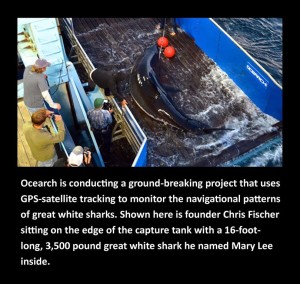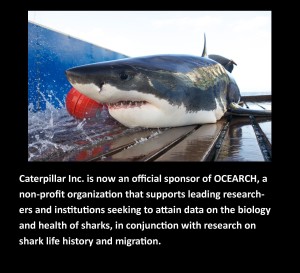
Ocearch: Tracking Great White Sharks
Ocearch: Tracking Great White Sharks


Fifteen minutes. That’s the maximum amount of time a team of scientists gives themselves to catch a great white shark, run tests, tag it and then release it, all for the sake of satisfying their curiosities about this mysterious creature of the ocean they named Mary Lee.
They are part of a team called Ocearch, which is conducting a ground-breaking project that uses GPS-satellite tracking to monitor the navigational patterns of sharks.
After capturing Mary Lee and giving her a water supply, the scientists then draw blood and run a battery of tests. Then they insert a honing device into her dorsal fin. It is essentially a built-in GPS that pings off a satellite capable of tracking her anywhere she swims in the world.
By attaching the GPS tags to them, people can track the sharks’ movements online with the Ocearch Global Shark Tracker. The team is currently tracking nearly 40 sharks, including Mary Lee.
Click here to track the sharks!
Chris Fischer—an appropriate name for the former star of the History Channel reality TV show “Shark Wranglers“—founded Ocearch and spends his life fishing for great white sharks to learn about their movements. Ocearch is also the name of Fischer’s boat, where he spends most of his days trying to crack of the code of one of the ocean’s most feared predators.
With the blockbuster movie “Jaws,” Steven Spielberg single handedly incited terror about what could be lurking close to shore. Now, almost 40 years later, Fischer is trying to dispel some of the fear and mystery by putting great whites on the map—literally.
“Nobody knows what they used to do,” Fischer said. “This is the first time we’re establishing these tracks to understand what normal even is. People say, ‘what is Mary lee doing? Is she cruising up the south eastern coast of the US?’ The fact is we don’t’ really know. Those things will become apparent over about two years.”
On the Shark Tracker, sharks that have been tagged appear as bright colored dots. Orange means a ping is less than 72 hours old, green means a ping is less than 30 days old and blue means a ping is more than 30 days old.
Mary Lee, an orange dot that has been hovering off the East Coast, was the shark that surprised everyone on Jan. 30. Unbeknownst to many New Yorkers, she paid a little visit just off the coast of East Quoque, Long Island.
“Mary Lee’s track is the perfect example of why people don’t need to be worried about sharks when they go swimming,” Fischer said. “She has cruised the entire length of the eastern seaboard on the beach… and nothing has happened right? That is a perfect example of let’s talk about this explorer rather than fear.”
Fischer named the 16-foot-long, 3,500 pound great white after his mother, and she is just one of two North Atlantic great whites he caught in September in the fictitious home of “Jaws“—just off the coast of Cape Cod.
One million people a month check into the global tracking website to follow Mary Lee and other sharks’ courses online. In just the past six months, Mary Lee has traversed the length of the East Coast, hugging the shoreline from Massachusetts to Jacksonville, Fla.
“I had to call the authorities in Jacksonville Beach because Mary Lee moved right in,” Fischer said. “She was within 200 yards in a surf spot in a public pier and I was at home and it was 11:30 at night and was like, ‘man, what if people are going to go surfing there in the morning?’”
Mary Lee then left Florida and went back up to Rhode Island, and was most recently spotted in the vicinity of Bermuda.
But the work Fischer and his team are doing doesn’t come without its critics. Some environmentalists say the Ocearch shark tracking device is too invasive and that the team is harming the sharks, but Fischer said that’s not the case. The real outrage, Fischer said, should be at the images that show thousands of freshly sliced shark fins heading to market in several Asian countries, such as Japan and China.
“In our accelerometer data it shows that they recovered in less than a half an hour,” he said. “We have the data now to understand that there’s not that much stress and there’s no time. What are you going to do? Sit back and chat about this for another day and allow another 200,000 be de-finned?”
Fischer believes his work could help save sharks from this process that many describe as barbaric, where shark fins are cut off the animal and then the rest of it is thrown back into the water. These fins are used to make a soup, viewed by many Asians as a rare delicacy.
“Think about all of the carcasses that are at the bottom of the ocean that are finless,” Fischer said. “You can’t remove the Apex predator from the ocean for a bowl of soup and expect the ocean to have a robust future.”
Greg Skomal, a marine biologist and one of the stars of Discovery Channel’s “Shark Week,” is also hunting for great white sharks. He joined forces with Fischer to learn more about them, but Skomal and his team use a different technique. Last summer, Skomal’s team successfully managed to harpoon a tag onto a shark found swimming not far off the beaches of Cape Cod.
Skomal believes Cape Cod is a great white hotspot, not because of the seals that live there, but for another attraction.
“My guess is that Cape Cod is a breeding site,” he said. “I believe that they will be breeding them in the fall and early winter, but that’s just my guess based on what we’ve seen around the world.”
While a great deal of Fischer’s research appears to be uncharted territory, he agrees with Skomal that breeding is largely what drives a lot of sharks’ behavior.
“Usually when you get a mature female and mature male coming together, you don’t have to be a rocket scientist with a Ph.D to think that maybe that was the breeding site,” Fischer said.
He can see on the Shark Tracker that male sharks tend to hang near the coast while females wander the open ocean. No one knows if sharks are coming closer to shore more now before or if their movements have changed over the years, Fischer said, but they are finally beginning to understand.
While these sharks are the largest predatory fish on earth, Fischer said they have been given a bad rap. With his team’s ground-breaking research, they are hopeful they will make some waves by replacing people’s fear of sharks with curiosity.
“It’s more dangerous to drive to the beach than to go swimming in the ocean,” he said. “[People are] tracking our sharks because we kind of opened up and shared it with the world. They wouldn’t even have shark or ocean on the brain, and that is really how this all began.”
Article courtesy of Linsey Davis and Meredith Frost via Nightline
